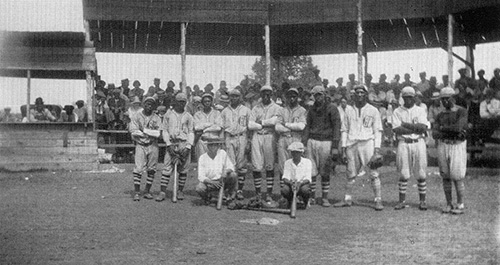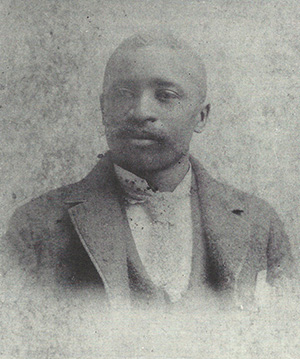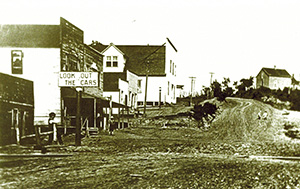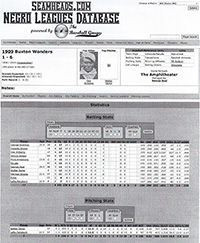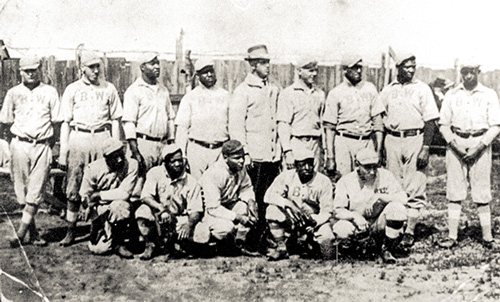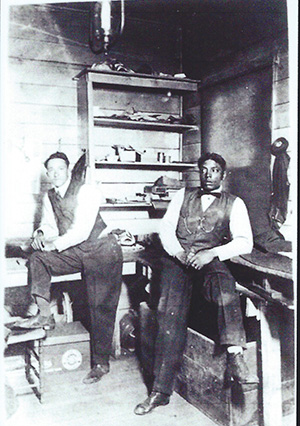
http://www.buxtoniowa.com • Consol, Haydock & Buxton Iowa, USA • 1871 - 2014
The Buxton Wonders Baseball Team
With spring comes baseball and my mind wanders to a time a century ago on the northern boundary of Monroe County in a place called Buxton where the Buxton “Wonders” played baseball at a very competitive level. The reputation of the team became legendary as the initially all-colored team beat the best professional baseball teams, including some say the Major League teams of that period.
While it is doubtful they played and beat Major League teams, they did play the better predominantly black teams of the era including the Minneapolis Keystones, the St. Paul Bombers, the Chicago Leland Giants, the Tennessee Rats and the Kansas City Giants. The Wonders were organized around 1900, about the time Buxton was being developed as a coal mining camp as the Consolidation Coal Company moved its operation from Muchakinock, a mining camp just south of Oskaloosa, to Buxton. B.F. Cooper, who was black, was credited with organizing and managing the team.
Coopertown was as we would describe it today, a suburb of Buxton. It was named after B.F. Cooper. My grandfather, David Peterson, owned a general store with Albert Hagglund in Coopertown that was adjacent to B.F. Cooper’s drug store. A large portion of Coopertown, including the stores of my grandfather and Cooper, were destroyed by fire in 1916.
A number of baseball parks were located in and around Buxton. The largest and most prominent park called the Amphitheater was located at Taits Corners in the southeast corner of Buxton proper. According to my dad, Reynold Peterson, Taits Corner and the area known as Sharp’s Bend were in the same vicinity south of Buxton’s 14th Street. The northwest corner at the intersection of T31 (650th Avenue) and H16 (110th Street) is where southeast Buxton proper was located. The slaughterhouse of Hobe Armstrong and other businesses were located in that area. It was known as a tough area. A pistol stolen from my grandfather’s brother Oscar was used in a murder in that area. The pistol was returned to Oscar by the Constable Tom Roman and remains in the family to this day.
Other ballparks I was told about included a park in the Coopertown/Gainestown area directly north of Buxton in Mahaska County. Another park was also located in Mahaska County, but just north of East Swede Town. It sat northeast of the “T” intersection of 650th Avenue and 340th Street.
Since the win-loss record for the team is not known, the extent of their greatness is left pretty much to their reputation and their legacy that has been passed down over the last 100 years. That said, the current Albia newspaper, the Union-Republican, prints a weekly series “Looking Back by Eric Bishop” that researches newspaper archives over the past 110 years. Those archives report the Wonders losing to other coal mining camp teams as well as to the Albia town team. The Albia team was reputed to have refused to play the Wonders because it had colored players on it. Apparently that was false or the Albia team changed its attitude over a period of time. In 1909, the Wonders beat the highly regarded Chicago Union Giants 6-1. The Chicago team won 80% of their games that year. As reported in the May 14th, 1913 issue of the Albia newspaper, the Browne Tennessee Rats a transient colored team beat the Buxton Wonders 3 to 2.
It is interesting to note in studying box scores for teams in that era that pitchers would pitch complete games with often only a days rest between starts. This was true in the Major Leagues. In 1906, a pitcher from my hometown of Charles City, Vive Lindaman, started 37 games and completed 32 for Boston in the National League.
My dad’s uncle, Hjalmer Nylander, joined the Wonders in 1909 as a teenager. Hjalmer was the younger brother of my grandmother Emma Peterson and the son of Adolf and Anna Nylander who immigrated from Sweden to Muchakinock in 1884. He must have been a fairly good player to be on the team as a teenager. He played seven years before he quit when he married Hazel Smith of Eveland. According to my dad, Hjalmer was a first baseman. My grandfather, David Peterson, was the brother-in-law of Hjalmer. Since my grandfather’s store was in the same building as the initial Wonders manager, B.F. Cooper’s pharmacy, I am sure that connection helped Hjalmer become a member of the team. It is to the credit of my family and Mr. Cooper that there was such a black-white respect between the families. However, I don’t believe that was unusual for those living in Buxton.
A 1912 team photo notes Ed Peterson as the manger having replaced George Neal who had earlier replaced B.F. Cooper. B.F. Cooper was one of the Nation’s first black pharmacists and a very good business man. The team was sponsored by the player’s employer, The Consolidation Coal Company. In a 1971 interview about his playing days with the Wonders, Hjalmer indicated that color of the skin was not an issue on the team. However, when the team played throughout the midwest, the black players stayed in the black hotels and white players in the white hotels. One problem for Hjalmer playing on the team at a relatively young age was the fact that his parents refused to allow him to play on Sundays. This was an issue since many of the games were played on the weekends. Hjalmer, according to my dad, would change in to his baseball uniform at my grandparents home in Buxton’s East Swede Town so his parents wouldn’t know he was playing baseball on the Sabbath.
Uncle Hjalmer was my first baseball player hero right along with Joe DiMaggio of the New York Yankees. Each summer in the 1950s I would visit my grandparents who at the time lived in the current home of Mark and Lisa Keeton (formerly the Bloom house) in Buxton’s East Swede Town. Uncle Hjalmer and Aunt Hazel would visit my grandparents from their home in Bussey. Uncle Hjalmer and I would play catch with the baseball in the front yard of the house. Uncle Hjalmer was a big St. Louis Cardinals fan. He named his dog for Roger Hornsby, Cardinal Hall of Fame second baseman. The memories are awesome.
The movie “Field of Dreams” crosses my thoughts as I think about there being a baseball field on one of the old baseball field location in Buxton where the Wonders once played. Then, just maybe, Uncle Hjalmer and other members of the Buxton Wonders including Sugar, my dad’s favorite player other than his Uncle Hjalmer, would once again be playing baseball. In my “Field of Dreams”I would be the bat boy for the Buxton Wonders.
Gordon Peterson the writer has been interested in the history of the coal mining camps in Monroe County for most of his life. He lives in Minneapolis, Minnesota. The writer’s family history is deep-rooted in the coal mining camps of Muchakinock, Buxton’s East Swede Town, Coopertown, Consol and Haydock. In 2016, the writer liked to suggest, he possibly is the only person alive that once played catch with a former Buxton Wonder baseball player when in the early 1950’s he played catch with his Dad’s Uncle Hjalmer Nylander, a former Buxton Wonder player.
